
Euphorbia misera is a semi-succulent shrub in the genus Euphorbia commonly known as the cliff spurge or coast spurge. A drought-deciduous shrub, it is typically found as a gnarled, straggly plant occupying seashore bluffs, hills and deserts. Like other members of its genus, it has a milky sap, which can be found exuding out of the light gray bark when damaged. The alternately-arranged leaves are round and folded in the middle, with small hairs on them. The "flowers" can be found blooming year-round, and are colored maroon or yellow in the center with 5 white to light-yellow petal-like appendages attached outside. This species is native to the Baja California peninsula and Sonora in Mexico, and the coast of southern California in the United States, where it is a rare species. It is threatened in some localities by the development of its coastal habitat, which tends to be prime locations for high-end residential and commercial developments.
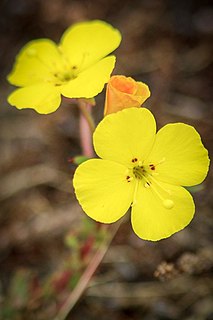
Camissoniopsis bistorta is a species of flowering plant in the evening primrose family known by the common names southern suncup and California suncup. It is native to southern California and Baja California, where it grows in several types of plant community along the coast and in the coastal hills and mountain ranges. This is a hairy annual or short-lived perennial herb spreading from a basal rosette, with stems reaching up to 80 centimeters long. The leaves are narrow and sometimes toothed, and 1 to 12 centimeters in length. Toward the end of the spreading stems are nodding inflorescences of flowers, each flower with four bright yellow petals dotted with red at their bases.

Salvia brandegeei is a perennial evergreen shrub in the mint family known by the common names Santa Rosa Island sage or Brandegee's sage. It is a fragrant plant characterized by lavender flowers and dark green leaves. For many years, it was thought to be native only to Santa Rosa Island, one of the Channel Islands of California, until it was discovered along the coast of Baja California. It is threatened by development and mining along the mainland portions of its range, but otherwise has a stable population on Santa Rosa Island.
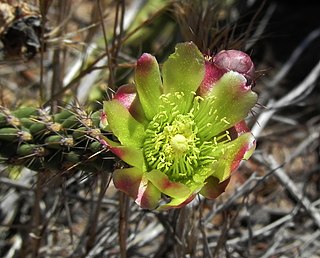
Cylindropuntia californica is a species of cholla cactus known by the common name snake cholla. It is primarily found in Baja California, Mexico and the southernmost part of California in the United States. It is characterized by a short, decumbent habit, yellow-green flowers, elongated stems, and short spines. It is mostly found in coastal sage scrub and coastal chaparral habitats, but two varieties in Baja California can be found in foothills and deserts. In California, variety californica is regarded as a rare and threatened plant, with a California Native Plant Society listing of 1B.1, in part due to its limited number of occurrences and threats from development. It formerly had a larger range due to the inclusion of Cylindropuntia bernardina within it as the variety parkeri.
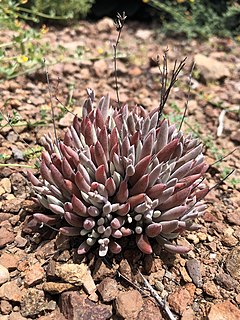
Dudleya attenuata is a species of perennial succulent plant known by the common name taper-tip liveforever, native to Baja California and a small portion of California. A rosette-forming leaf succulent, it has narrow pencil shaped leaves that can often be found covered in a white epicuticular wax. The thin, sprawling stems branch to form the clusters of rosettes, with plants creating a "clump" up to 40 cm wide. The small flowers are white or yellow, with 5 spreading petals. It is a diverse, variable species that extends from the southernmost coast of San Diego County to an area slightly north of the Vizcaino Desert, hybridizing with many other species of Dudleya in its range. Some plants with white or pinkish flowers were referred to as Orcutt's liveforever, referring to a former subspecies split on the basis of the flower color.
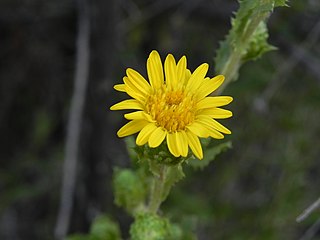
Hazardia berberidis is a species of flowering plant in the family Asteraceae commonly known as the barberry-leaf goldenbush. A woody shrub, it is characterized by sawtooth leaves and yellow ray flowers that bloom from March to August. It is endemic to the coastal sage scrub and coastal succulent scrub habitats of Baja California, Mexico, but with populations of uncertain origin in San Diego County, California.

Dicranostegia is a monotypic genus of hemiparasitic flowering plants belonging to the family Orobanchaceae, containing the species Dicranostegia orcuttiana, commonly known as Orcutt's bird's beak or Baja bird's beak. It is near-endemic to Baja California, found from Miller's Landing north to Tijuana, but has a few occurrences in southern San Diego County, California. It is differentiated among other similar species in California by its leaves with 8 to 11 lateral lobes that are paired. It was formerly placed in the genus Cordylanthus until phylogenetic analysis led to it being split off. This species is threatened by the destruction of its habitat from urbanization.
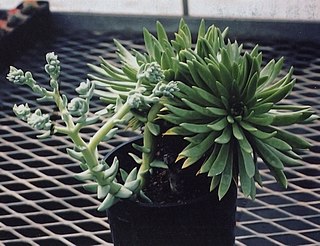
Dudleya guadalupensis is a very rare species of succulent perennial plant in the family Crassulaceae commonly known as the Guadalupe liveforever. It is a rosette-forming leaf succulent, with foliage that is variously colored light green, green, and a waxy white. It is characterized by dense leaves that fold over the center in dormancy, a curving, sinuous flower stalk, and white, cup-shaped flowers. It is endemic to the rocks and islets off of Guadalupe Island, an isolated volcanic island in the Pacific Ocean located 241 kilometers off of the coast of Baja California.

Dudleya gatesii, known by the common name as Gates'liveforever, is a species of perennial succulent plant in the family Crassulaceae. It is native to the central desert of the Baja California peninsula, found growing along dry and rocky outcroppings. It is characterized by red inflorescences topped with white flowers, bracts that are often reflexed downwards, and a rosette of dark-green leaves turning reddish.
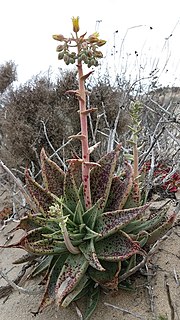
Dudleya acuminata is a species of succulent perennial plant in the family Crassulaceae known by common name as the Vizcaino liveforever. A rosette-forming leaf succulent, it has reddish yellow flowers that emerge from April to May. It is native to the Pacific coast of the Vizcaino Desert on the Baja California Peninsula, and on neighboring islands.

Eriogonum preclarum, known commonly as the Puerto Nuevo buckwheat, is a very rare species of perennial wild buckwheat in the family Polygonaceae. It is endemic to the Vizcaíno Peninsula in Baja California Sur, occurring on ultramafic substrates.
Sedum alamosanum, known by the common name Alamos stonecrop, is a rare succulent plant native to the mountains of northwestern Mexico. It is characterized by white flowers and bluish-green leaves. It is found in Baja California Sur, Chihuahua, Durango, Sinaloa and Sonora.
Dudleya crassifolia is a species of drought deciduous, corm-forming succulent plant known by common name as the thick-leaf dudleya. It is an incredibly rare and cryptic plant native to one small locale less than a hectare in area on the Colonet peninsula in Baja California. It is threatened by urban development, including a proposed seaport. It is characterized by white, spreading flowers with leaf bases that are persistent on the stem. Although it did not receive as much media attention as the neighboring Dudleya hendrixii, it has been noted that the plant has several similarities to cryptic succulents like Anacampseros.

Jatropha moranii is a very rare subshrub in the genus Jatropha known commonly as Moran's lomboy. This species in the family Euphorbiaceae is endemic to a small area of Cabo San Lucas in Baja California Sur. It is characterized by a succulent stem and branches, along with a distinct woody caudex, and attractive white flowers.

Nahuatlea aborescens is a species of tree in the Composite family endemic to the Cape region and Cerralvo Island of Baja California Sur, commonly known as ocote. It grows up to 8 meters tall, with monoecious tan-colored flowers and short, leafy branchlets. It was formerly in the genus Gochnatia, where it was known commonly as the tree gochnatia.
Amorpha apiculata is a species of papilionate leguminous shrub known commonly as the Baja California false-indigo. It is a very rare narrow endemic only found in the Sierra de San Pedro Martir and its western foothills. It is characterized by a white vexillum, a smooth, hairless fruit and spine-like glands. It is closely related to Amorpha californica.

Lysiloma candidum, most commonly known as the palo blanco, is a tree of the family Fabaceae near-endemic to the Baja California Peninsula in Mexico. It may grow to a height of 10 metres (33 ft) and is one of the few spineless woody legumes in the region. It has compound leaves with oval gray-green leaflets. The creamy-white, globose clusters of flowers bloom in March through May and perfume the air with a light, spicy fragrance. The flowers are followed by red-brown pods up to 15 centimetres (5.9 in) long that hang delicately on the thin branches. This species is distributed throughout the Baja California Peninsula, from Rancho El Barril in southern Baja California state to the Cape region of Baja California Sur, and is also very rarely found in the state of Sonora.
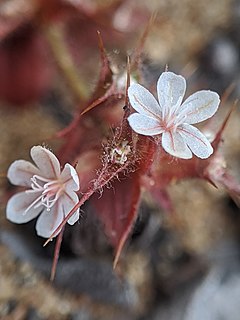
Mucronea californica is a rare species of annual plant in the family Polygonaceae known by the common names California spineflower or California mucronea. An ephemeral plant found growing in the sandy microhabitats of coastal sage scrub, chaparral and dunes, this plant is threatened by the urbanization and development of its viable habitat and has been locally extirpated over much of its range. It has small, white to pink flowers that top inflorescences spined with awns.

Lepechinia hastata is a rare species of perennial shrub in the mint family commonly known as the Cape pitcher sage or Baja pitcher sage. An aromatic plant, it is characterized by attractive magenta to purple flowers. The plant is slightly woody at the base, and has large arrowhead-shaped leaves. In the wild, it is only known from the forested mountains of the Sierra de La Laguna in Baja California Sur and the volcanic Socorro Island in the Pacific Ocean. The plants of Socorro Island represent their own subspecies. It is also found in the Hawaiian island of Maui where it is known as pakaha. It is unclear if the Hawaiian plants are introduced or represent a natural disjunct population. In horticulture, this plant is a widely-cultivated ornamental. It is one of three species of Lepechinia in the Baja California area, with the other two, Lepechinia ganderi and Lepechinia cardiophylla, found far to the north in drier chaparral habitat.

Convolvulus simulans is a species of annual plant in the morning glory family known as the small-flowered morning-glory and small-flowered bindweed. It is an inconspicuous vining plant that is characterized by tiny pale pink or pale blue bell-shaped flowers. It is typically restricted to clay and serpentine substrates in annual grassland, coastal sage scrub and chaparral habitats. This species is native to Arizona, California, and Baja California. Some taxonomies place this species under Convolvulus equitans.

















